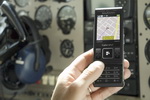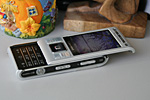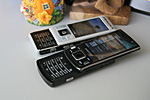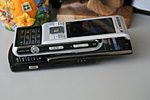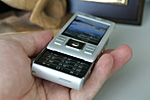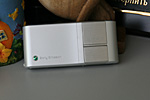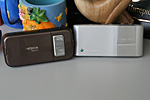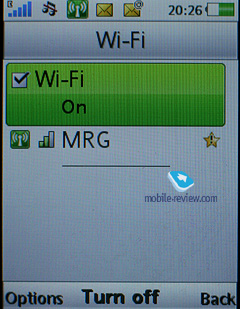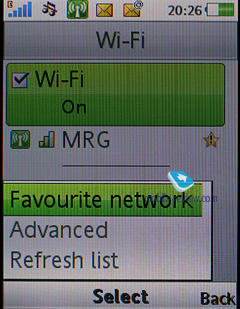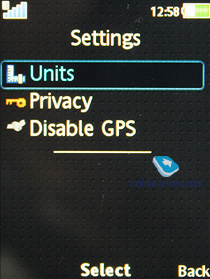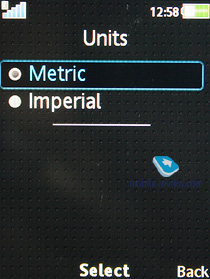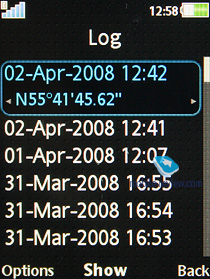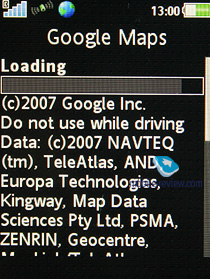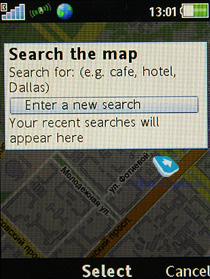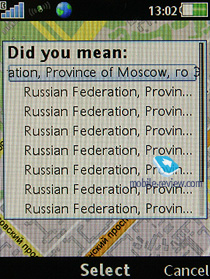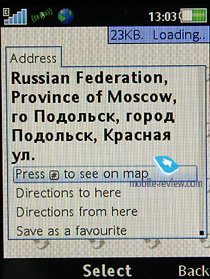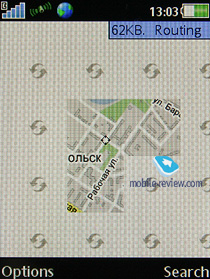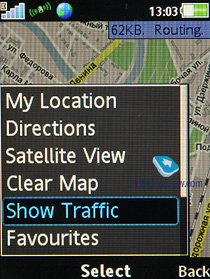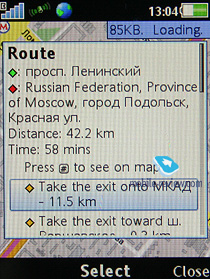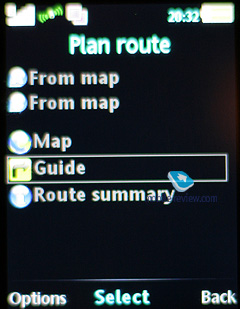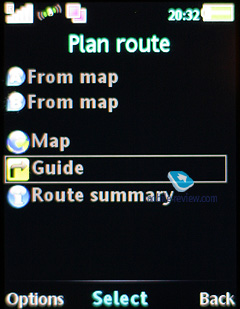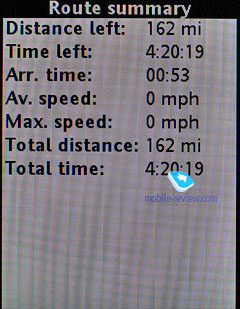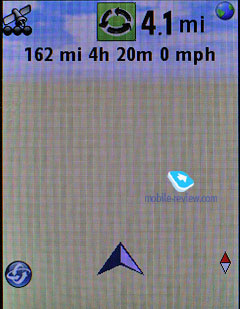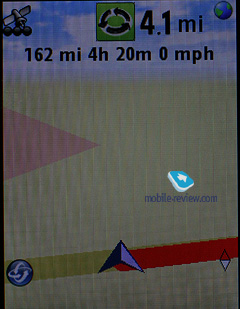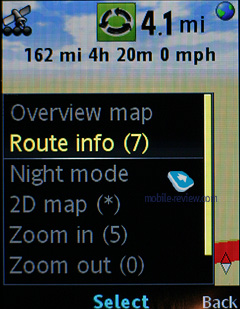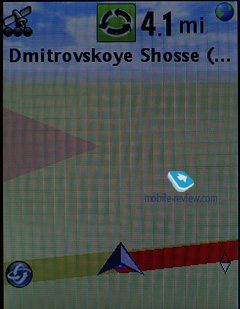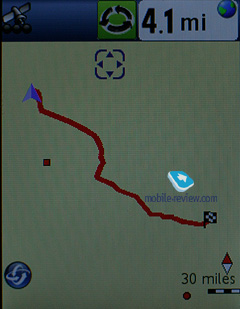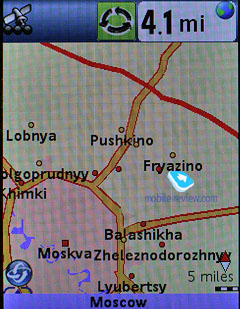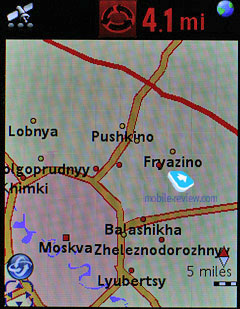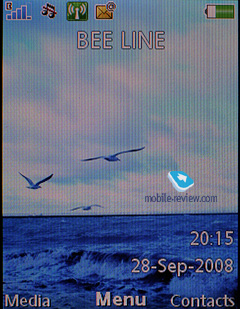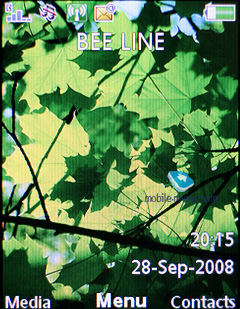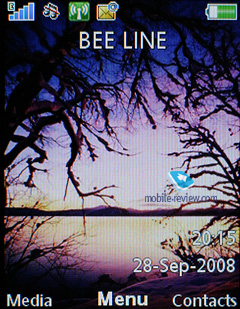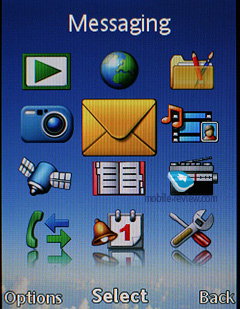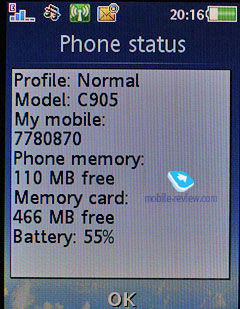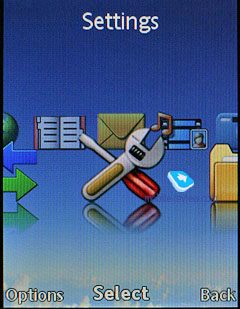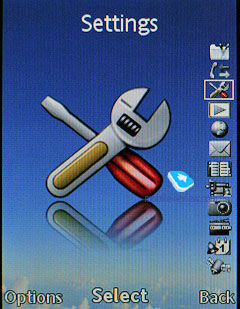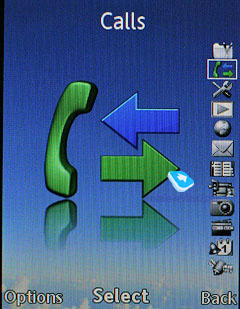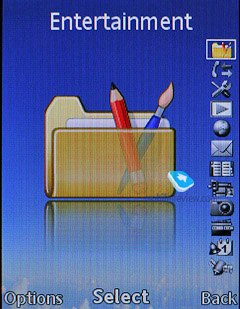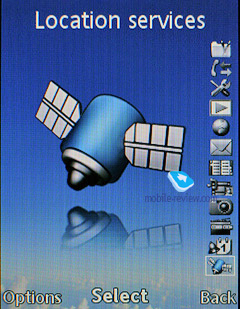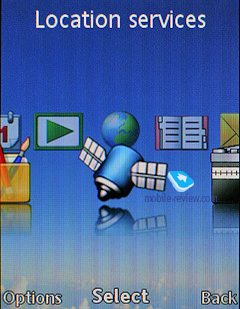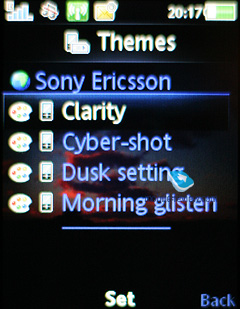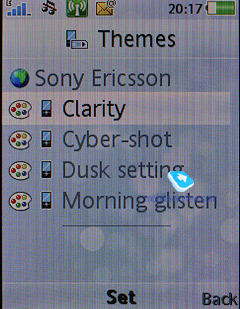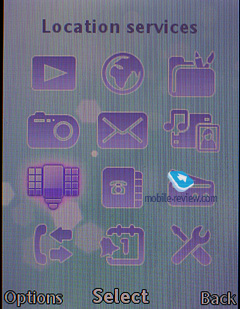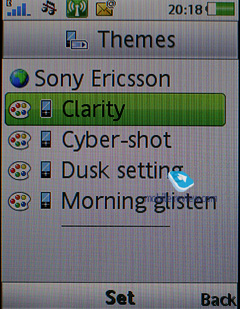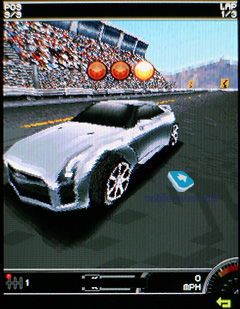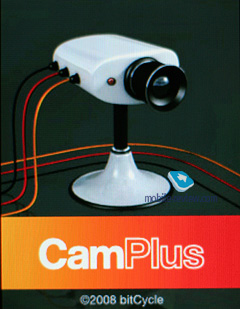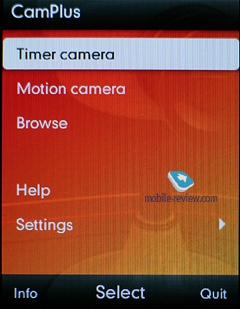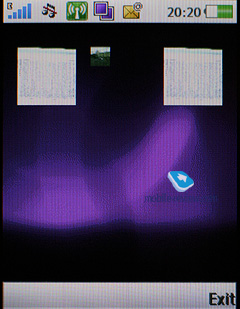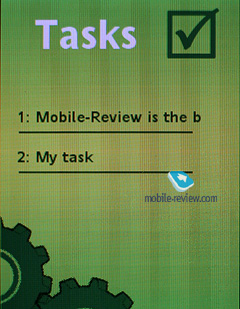|
|
Review of GSM/UMTS-handset Sony Ericsson C905
Live images of the Sony Ericsson C905
Table of Contents:
- Positioning
- Design, Size, Controls
- Display
- Keypad
- Battery
- Memory, Memory cards
- Connectivity
- Performance
- GPS-navigation
- Preinstalled applications, games, themes
- Capuchin Project
- Impressions
Sales package:
- Handset
- 950 mAh Li-Ion battery
- Charger
- 2Gb M2 memory card
- Software CD
- USB data cable
- User Guide
- Wired stereo-headset (HPM-62)
We have a separate write-up on the C905's camera
Positioning
The C905 comes in as the new flagship of the imaging-savvy Cyber-shot line-up, which would normally mean it's THE ultimate phone in Sony Ericsson's portfolio, but since they have changed their priorities a bit, the C905 is a totally different creature. Having kicked off with the all-in-one functionality for every offering, raising a whole generation of users along the way, Sony Ericsson deviated from this strategy, so these days their phones can't "do it all" anymore and rather focus on some specific features. Although they will never seem to be all that different, for all Sony Ericsson branded handsets run the same platform and while keeping the basics intact get one or two new feats and abilities on top of that.

The Cyber-shot range was supposed to become the saving grace for Sony Ericsson - we all remember what a success the Sony Ericsson T610 was (all thanks to its bundled camera), then the world saw the K750 that revolutionized the way we viewed cameras in mobile phones back then. The next phone of this breed, the Sony Ericsson K800i was quite likable as well, but at the same time didn't have that touch of novelty anymore, and that was the tipping point, when Sony Ericsson's grip on the market of imaging-savvy handset market began to fade. Around the same time they got a painful nudge from Nokia and their top-of-the-line N95 - the world's first 5 Mpix camera phone that beat Sony Ericsson to the market by almost six months. By the time their K850i came along, it was neither state-of-the-art, nor longed-for, even though it still offered a couple of nice touches, such as a xenon flash, revamped camera interface and some new applications. Sales-wise it didn't even come close to it predecessors, despite Sony Ericsson gaining more weight on the global market. That's why they put a lot of thought and effort into their next imaging-centric solution, which is the focus of today's write-up - the C905. They saw it as a preeminent phone in all departments with a decent camera, a wealth of features that, supposedly, had to ensure reasonable sales in the price-bracket the C905 was targeting. Back then Sony Ericsson thought that such an early launch and no competition whatsoever would guarantee the C905 a pretty easy walk. But having focused their attention on Nokia alone, they completely overlooked Samsung's efforts in this field, which was a major misstep - while negotiating supplies of camera modules for Sony Ericsson's phones, Samsung initiated their own photo-savvy line-up. That's why early prototypes of the C905 employed a different camera module; in fact they had to change it shortly before the release and try to tweak it with very little time left on their hands. Apparently, having wasted a lot of time, Sony Ericsson have ended up two weeks behind the Samsung INNOV8 that puts up pretty much the same camera quality but offers the power of S60 OS that makes the C905 look pale in comparison.
In turn, Sony Ericsson tried to retaliate and slashed the C905's price, so that they'd be able to make up for the difference in specs. But an avalanche of problems with production and very thin supplies have made this plan nearly unfeasible. Distributors will keep running out of stock simply because Sony Ericsson won't be able to ship enough units in time, the reason being that when drafting the sales plan they went by the forecasts made by their partners that were on the pessimistic side. Here is one of them - "While we placed an order for the C905 since it's a new phone, we don't expect it to sell very well given its overly hefty price tag. We are banking more on such products as the LG KC910 and Samsung M8800, whose more adequate price will attract a larger portion of the audience. A fair price for the C905 would be 450 Euro, which is way below its current 675 Euro tag. All in all, it's remarkably similar to the Sony Ericsson S700 and will appeal more to this brand's fans; and we have reasons to believe it will have a similar sales profile - a surge of interest at start, followed by a rapid decline in sales that will last until the end of this phone's life cycle. It's very likely that the C905 won't even reach the sales of the Sony Ericsson K850 that failed to generate significant numbers in its day at that. We don't put much stock in this product, especially since Sony Ericsson aren't going to tout it as much as the K850i, or we haven't been informed of such a campaign yet."

Here is another point of view on the C905's future from a CEO of a major retail network - "The C905 will do for Sony Ericsson's die-hard fans and we assume it'll enjoy relatively decent sales during first couple of weeks. Then we will drop its price a little - it'll be a minute cut, since there is no point in dumping it primarily because of this phone's dismal sales forecast. After that we will try to get rid of all our supplies and only restock in the amounts we think we'll be able to distribute. Consumers don't seem overly enthusiastic about the C905, so we see no reason why we'd need to bank on this particular offering or advertise it on our own, seeing how little effort Sony Ericsson have put into this field. You better take a look at Sony's digital cameras - these things will be really hot this Christmas!"
Having received this kind of feedback, Sony Ericsson went ahead and altered their plans regarding the C905. While in June they spread the word that its retail price won't go over 550 Euro mark, these days it's floating somewhere around 650-680 Euro. Essentially, this is all another proof that they don't feel all that enthusiastic about the C905's sales either; furthermore Sony Ericsson haven't even published any C905-related documents over at their resource for distributors (by contrast, the W902 is already out there and full specced), and the section for developers still features specifications of the old camera module with shooting modes and effects that have been omitted from the retail edition of the C905.

On balance, the C905 is the way to go for Sony Ericsson fans who know a little something about cameras as well. The fact that Sony Ericsson have a bunch of similarly-priced fashion-conscious solutions slotted for the end of 2008, left them no choice but to deprive the C905 of all sorts of even half-way decent materials in an effort to avoid needless rivalry with their future phones. All up, the Sony Ericsson C905 is more of a camera wrapped up as a mobile phone, and that's exactly how it's positioned.
Honestly, I have a hard time trying to describe this phone's target audience. But I believe it'll include mainly those who have already gotten used to Sony Ericsson's style and don't really want to change sides just yet; plus they don't care much about prices or need supreme image quality. I think you'll agree, however, that this audience profile looks a little bit far-fetched and very few consumers actually fall under this category. Major shifts in the market strategy have made Sony Ericsson's positions slip in many regions, including Russia. They are now losing the market and the C905 is another "why" - frankly, Sony Ericsson have been on a downswing since the release of the K800, and every new imaging-savvy phone has being eroding their market share even further.
Another misstep is the fact that they have overvalued the C905's camera - as far as the mass market goes, 5 MP is considered a decent megapixel count and very few are looking for even more sophisticated solutions. These days the running theme is price/quality ratio, but in this regard the Sony Ericsson C905 is not a favorite by any stretch of imagination.
Back to the table of contents>>>
Design, Size, Controls
The phone comes in a choice of three colors - Night Black, Ice Silver and Copper Gold.

The C905 measures up at 104x49x18 mm, with the part where the camera module is housed being around 19.5 mm thick. All in all, it's neither diminutive, nor lightweight at 136 grams, it rather feels somewhat bricky in the hand. What's more, there are no metallic accents in it whatsoever; which is quite odd, considering the C905's weight. In fact, in the materials department, the Sony Ericsson C905 is nothing to write home about - apart from plastic it sports only a piece of mineral glass covering the display.


Sony Ericsson C905 vs Samsung INNOV8:
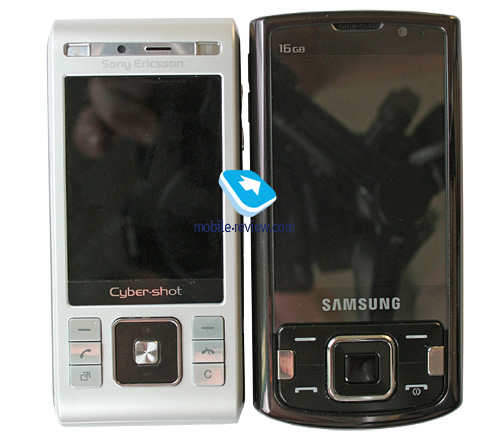
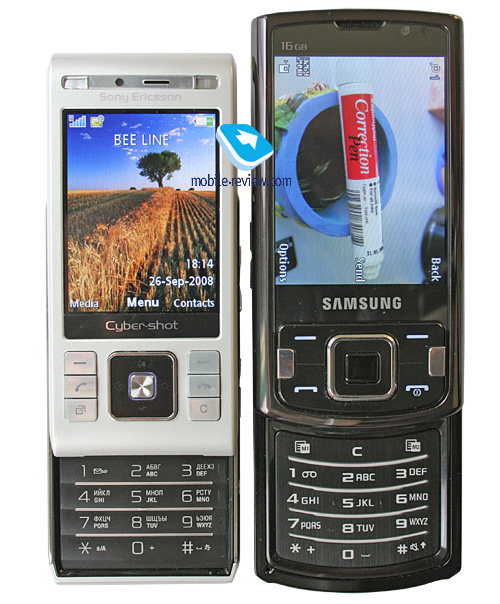
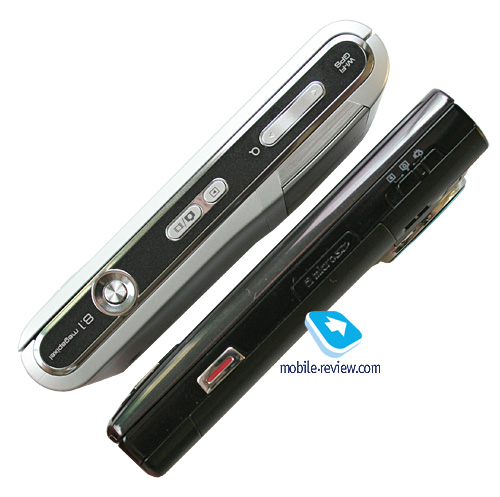
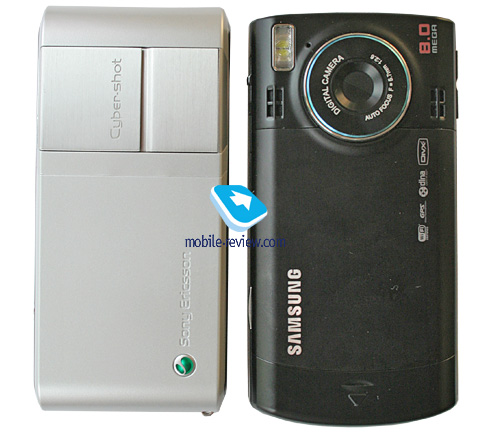
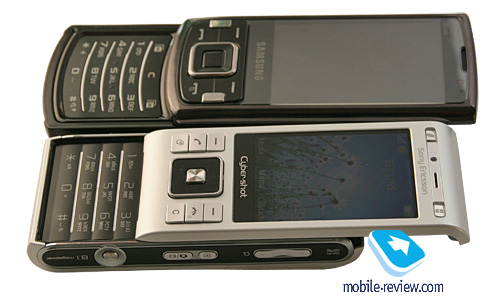
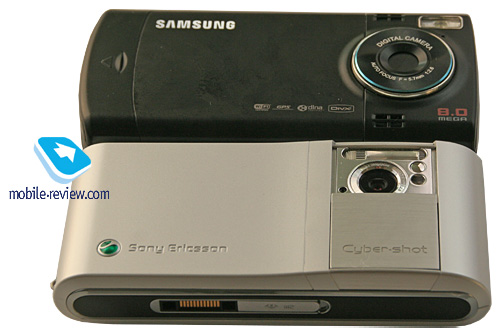
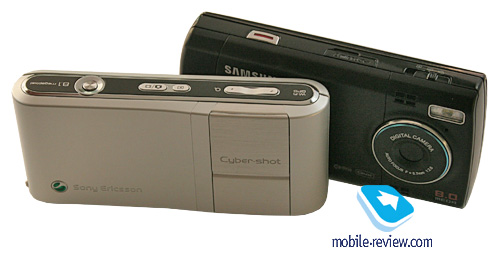
Sony Ericsson C905 vs Nokia N85:

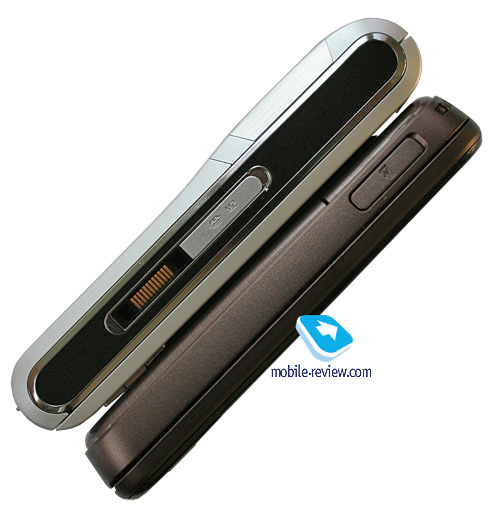
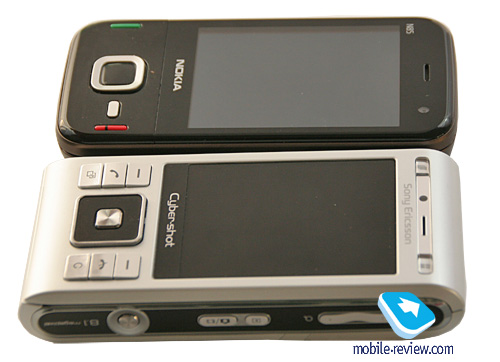


Sony Ericsson C905 vs Nokia N96:


I can't say much about the C905's coating quality, though - the prototypes we got our hands on seemed quite prone to wear and tear, as their paint got dimmer in several months' time. At the same time, it's hard to say whether commercial units will be just as intolerant of everyday abuse. As far as other elements go, however, we can't overlook the C905's overly soft lens cover that picks up scratches in no time even when you put it on some reasonably clean surface and move it around a bit. It looks slick, make no mistake about that, but these scratches take away a good chunk of the lens cover's charm.

While the slider mechanism doesn't feel wobbly, it creaks as if it was some second-rate phone. Just close the phone, grasp the top half and try moving it back and forth, left and right and listen to what sounds it'll make- basically, it's our major gripe with the phone, as we'd never expect a 600 Euro handset to be that squeaky. On top of that, the soft-keys make creaking sounds when pressed too. The spring-loaded mechanism is on the stiffer side and you'll have to put some effort into it to flick the phone open; and the problem here is the way the C905's designed. The top half is considerably thinner than the phone's main part - such an unbalanced build makes the halves so reluctant to move up and down. Furthermore, the C905's metallic runners make a distinguishable, yet somewhat muffled, crunching noise.

Honestly, I tried to re-write the previous paragraph a couple of times, and at some point I even started to think that I made up the whole story about it being such a creaker. So, in order to remove all possible bias from our verdict on the phone's build quality, I handed it out to several people and asked them for quick reviews. Interestingly, most of them complained about it being too noisy even without me asking about this issue. Unfortunately, that's the way the C905 is build and there is absolutely nothing you can do about it. Then I gave the same people Nokia N85 and Samsung INNOV8 that looked and felt rock solid in contrast the Sony Ericsson C905's creaking slider mechanism. On the other hand, while many might close their ears to these noises, thinking of them as an integral part of the phone's form-factor, it doesn't mean the C905 is defect-free on this front.
Video, C905's design and size (wmv, 21,3 mb) >>>
The lack of balance between the halves is another big problem of the C905's ergonomics, that makes typing SMS on the go quite a pain. Nevertheless, people with larger hands didn't experience any issues with the phone, while women complained about it being quite a challenge when it came to typing with one hand. On the other hand, all thanks to the C905's width, you can just grab it with both hands, in which case typing up messages becomes a breeze.


The slider mechanism left some marks on the right side of the keypad - while these scuffs won't hurt the C905's buttons in any way, it's still a crucial flaw in the phone's design, they shouldn't even be there in the first place.

I, for one, believe that all these blunders in the C905's build quality and ergonomics are largely due to Sony Ericsson's obsession with cost reduction - basically, they have opted to throw in some inferior materials without putting them a thorough field test, since it's quite an expensive procedure among all other things. During my quality time with the Sony Ericsson C905 several times I caught myself thinking that it was kind of similar to the Nokia N95 in this regard, although the latter didn't have that many issues with its build quality. But overall, in terms of size and general impressions, the C905 and N95 seem somewhat resembling, although it's not a good thing at all, for this price bracket calls for a totally different level of quality.
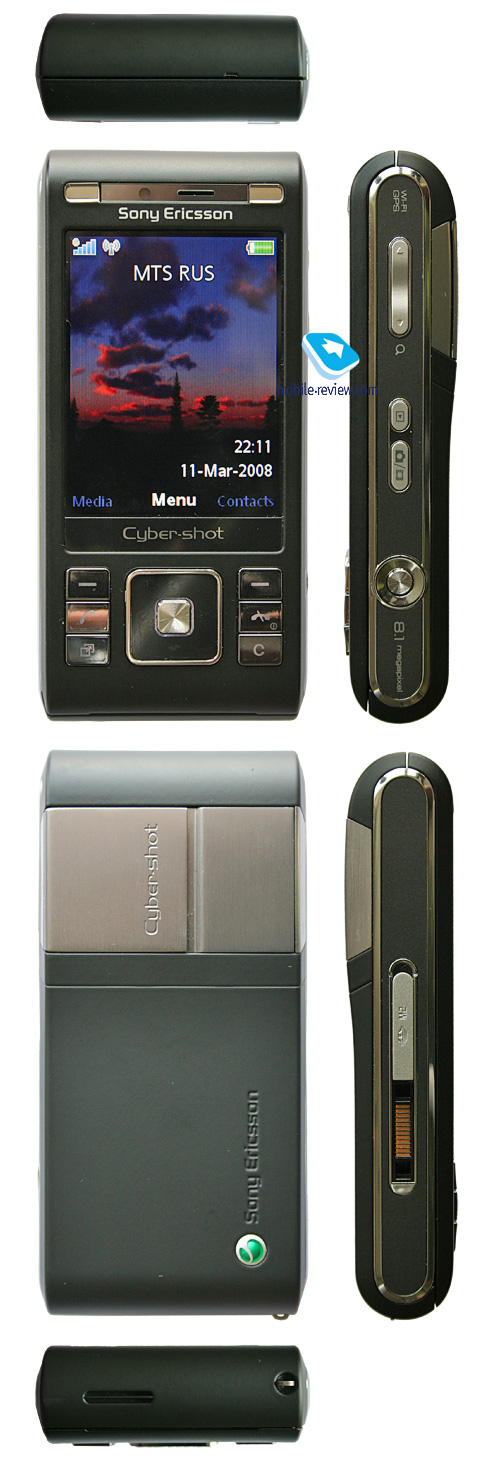
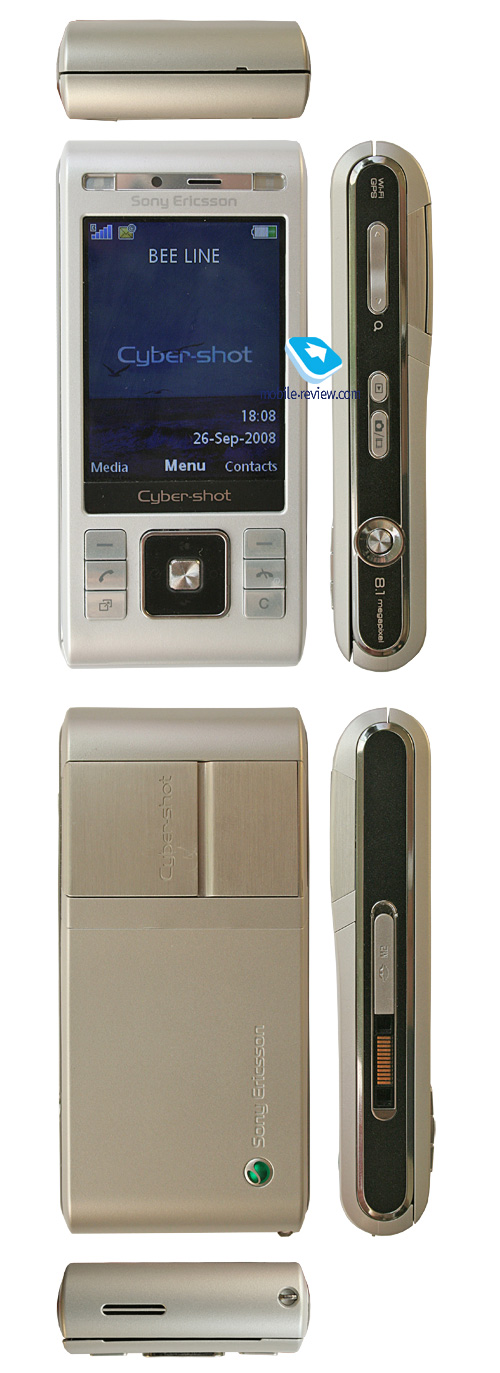
Sitting above the screen are two gallery shortcut keys; mounted on the left is the M2 memory card slot and standard Fast Port connector. The lanyard eyelet is found at the base of the C905, but very few will actually try wearing it around their necks. Finally, the right-hand spine features the volume rocker, camera controls and shutter-release button.


The 8 Mpix camera lens is protected by a sliding cover. Curiously, there is no forward-facing camera for video calls; luckily, though, they have kept the ambient light sensor on the same place.



Back to the table of contents>>>
Display
The C905 utilizes a 240x320 pixel TFT display (2.4 inches from corner to corner, 37x49mm) that shows up to 262K colors. Indoors the picture looks smooth, bright and crisp. In fact, as far as color reproduction goes, this is one of the market's finest units. The C905's screen can accommodate up to 9 text and 4 service lines with some modes allowing for even more information. It does well in the sun, but it gets somewhat washed out.



The bundled motion sensor allows the C905 to rotate the screen automatically, be it in the web-browser or image gallery.
Below is a quick comparison between the C905's display and that of the Samsung INNOV8.
Sony Ericsson C905 on the left:
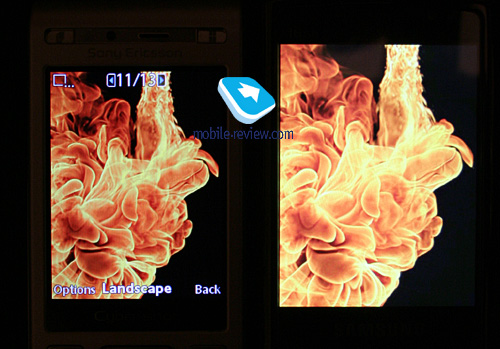
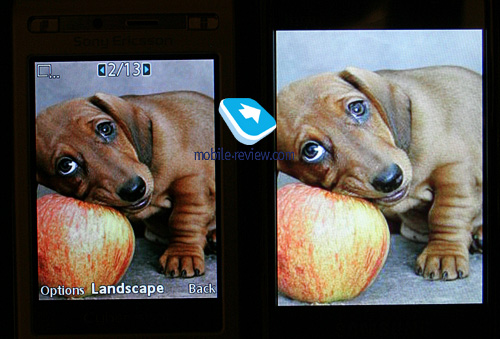
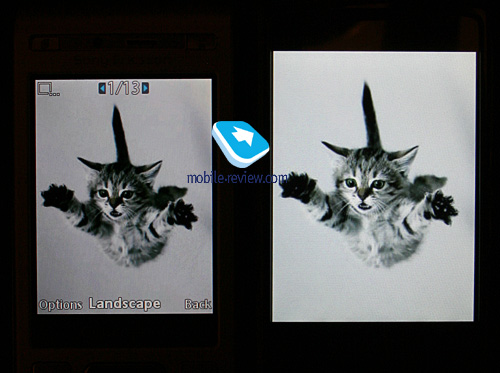
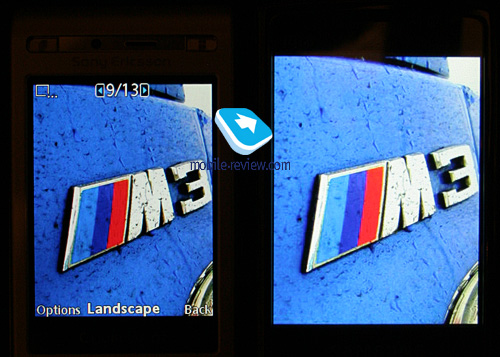
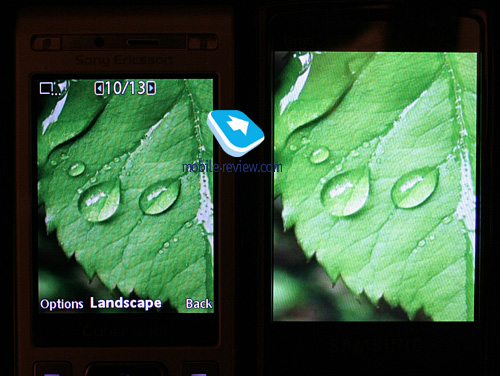
Back to the table of contents>>>
Keypad
The C905's navigation cluster is pretty comfortable to use, although it's got one irritating letdown - the soft-keys slightly creak when pressed. The numberpad enjoys a terraced layout, where the key rows are separated with silver finger guides. While all buttons are fairly responsive and easy to press, the phone's weight/size ratio takes away some of the keypad's ergonomics. All keys are lit in moderately bright white.








Back to the table of contents>>>
Battery
The C905 makes use of a 950 mAh Li-Pol battery (BST-38). As the manufacturer claims, it can keep the handset up and running up to 380 hours in standby and provide up to 9 hours of talk time.


In Moscow the C905 lasted around 2,5-3 days with average use - up to one hour of calls, around 30 minutes of games, 20 minutes of browsing, and several hours of music. In Europe its battery performance will get at least 1,5 times better all thanks to superior coverage. We squeezed around 18.5 hours of music out of the C905. It takes the Sony Ericsson C905 around 2 hours to charge from empty to full (1.5 hours to charge up to 80 percent).
WiFi time (non-stop file downloads) - 2.5 hours.
Navigation time (via WayFinder application) - around 3 hours.
If you turn Push Mail on and opt not to use the phone's navigation department at all, the C905 will last 6 to 9 hours. All in all, it's typical A200-based solution with slightly longer battery times in certain modes (navigation, WiFi).
Back to the table of contents>>>
Memory, memory cards
The C905 comes with around 160 Mb of user-manageable memory, the sales package also includes a 2 Gb memory card (M2), and you can always hot swap them. The top size of your memory card this phone can handle is 32 Gb (when more capable cards come along, it will deal with them as well).

Back to the table of contents>>>
Connectivity
USB
On USB-connection you are forced to pick connection type - specifically whether you will be accessing data stored on the memory card to just keep managing the phone or activate Print mode. Also there is Media Transfer (MTP mode for accessing, say, Windows Media Player). For the first mode we mentioned above the handset goes off and you gain access to the contents of both the memory card and the phone internal memory. Despite the maker claiming it to be USB 2.0, data transfer speed doesn't exceed 500 Kb/s. If you just want your C905 to turn into a modem, then pick the second option, when you will have a chance to play around with various USB settings for going online.
Bluetooth
The handset comes with EDR-enabled Bluetooth 2.0, the menu enables you to turn on enhanced power saving mode. There is also A2DP support, which allows employing wireless headsets with the C905. Its data transfer speed tops out at 100 Kb/s. The list of supported profiles:
- A2DP
- Basic Imaging Profile
- Basic Printing Profile
- Dial-Up Networking Profile
- File Transfer Profile
- Generic Access Profile
- Generic Object Exchange Profile
- Handsfree Profile
- Headset Profile
- HID
- JSR-82 Java API
- Object Push Profile
- Personal Area Network Profile
- Serial Port Profile
- Service Discovery Application Profile
- Synchronization Profile
- SyncML OBEX binding
WiFi
The C905 is the first phone running on A200 platform to support WiFi wireless connectivity (with DLNA certificate, 802.11 b/g). Luckily, it's not a paired-down option here, as the phone allows you to tap into active networks (passworded or not) or find new ones (by SSID). It also supports all input languages, which is pretty important for non-English speaking regions. On top of that, the C905 offers a list with your favorite networks which it will connect to automatically. You can opt to enable Power Saving mode, when the phone will cut all active connections if they are out of use.
Our main niggle with the C905's WiFi, however, is that while the phone offers a wealth of options, it won't last long - only 3 hours or so; and in case you prefer to have a WiFi connection in the background it will affect the battery life big time as well. Basically, it seems as if they haven't optimized power consumption for this option yet. Plus since there are no VoIP applications integrated with the phone's contact list, you won't be able to enjoy full-fledged SIP-telephony. So, all things considered, the C905's WiFi connectivity pales in comparison to that found in S60-based solutions mainly because of these two factors.
Another we need to mention is that the C905 rebooted a couple of times without any explanation when we were surfing the Web via WiFi (around three times in six hours, actually).
Back to the table of contents>>>
Performance
The C905's JP-8.4 update has severely affected its performance in our Java tests - in fact, it's results have nearly halved in JB1 and JB2 tests compared to other solutions. On the other hand, its interface is very responsive and speedy - we didn't experience any freeze-ups or hiccups in this department. At the same time, our JB 3D tests showed that the C905 fares much better than the competition, which is all another proof of how context-dependent these synthetic tests are. As far as JAR files go they can be of any size, while HEAP are limited to 1.5 Mb.
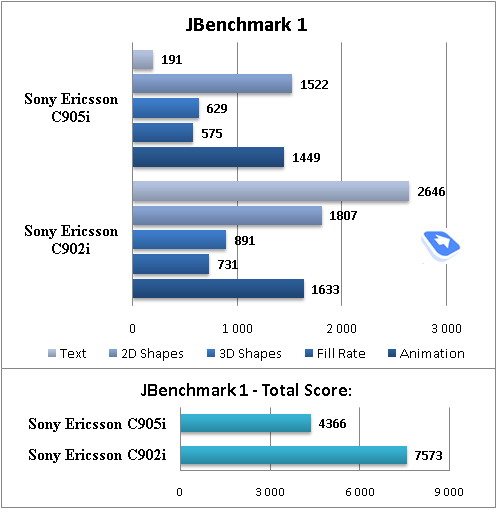
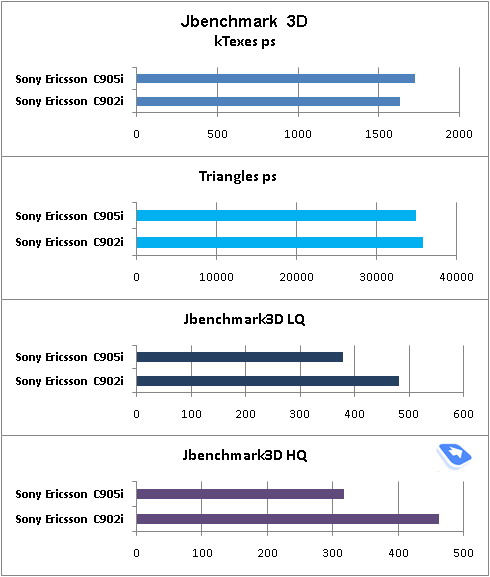
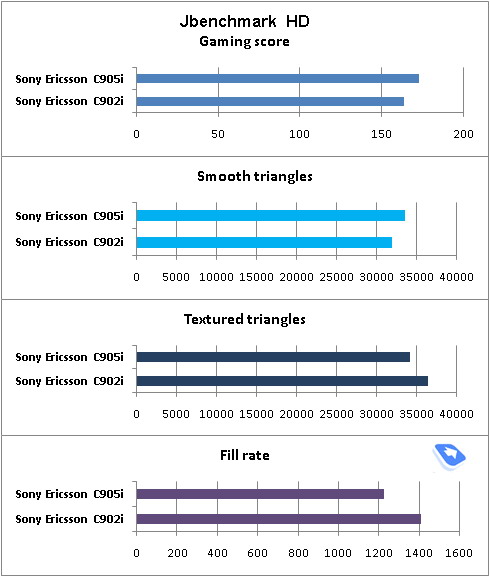
Back to the table of contents>>>
GPS-navigation
If we mark the Z750i as the first generation of Sony Ericsson's GPS-enabled solutions, then it's safe to say that the W760i and C905 represent the second generation primarily in terms of software. Sony Ericsson is banking on free Google Maps (version 2 in particular, with Cell ID functionality that allows getting a GPS fix on your location without having a real GPS-receiver onboard). This application can uploaded onto any phone, meaning that it is not all that unique; on the other hand Sony Ericsson has integrated this application right into the main menu and tweaked it a little bit here and there. New releases of these maps will be available both as separate applications and with firmware updates for the phone.
The main menu features "Location Services" item which comprises a couple of sub-menus with Google Maps sitting on top of the list. The presence of this service actually brings both positives and negatives - while it packs detailed maps of a multitude of cities, as well as the ability to update them on a regular basis, view some satellite photos and browse POI info, it has no local maps saved on your handset. This means that should you find yourself abroad, you will need to get a SIM-card from a local carrier, or go broke trying to pay all your traffic bills, or, the least acceptable option, dismiss the C905's navigation capabilities. To give you an idea how traffic-hungry this application is, let me show you an example: one session normally consumes 500-800 Kb of information and this includes only tracking a place on the map and calculating a route. In this sense Nokia Maps is much more preferable, for it allows you to store maps on your device and download new maps with your PC.
There is no point in examining Google Maps in this write-up - the application is very familiar to many and can be installed on just about any phone. Its main features include route calculation, location tracking (any language), POI data base. Maps can be scaled as well.
The way it is integrated into the C905 is going to surprise you with how basic it actually is. Your whereabouts are marked with a token on the map, so you can save your current location, throw it into Favorites, and calculate a route (which can't be saved, as you can only save some locations, and that's about it, however plotting a route between two points on the map is very easy).
Once launched, the application can be minimized, so you will find a satellite icon on the C905's display. The device comes with a 12-chanel receiver, kicking in only outdoors; cold start time - 4-5 minutes. The phone features a log of coordinates, so any location can be viewed later, which can make for offline browsing of your routes. But to do this you will need to synchronize the C905 to a notebook and with its Internet connection check out maps. And let's be honest, this is not very convenient.
There is a window offering you the number of currently available satellites and your speed. There windows are of no real use, though.
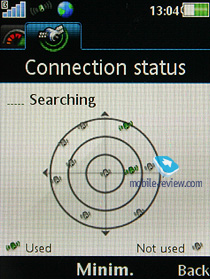
The C905 will stay up and running for around 3-3.5 hours when you use it solely for navigation purposes.
The Navigation item leads to Wayfinder Navigator - application that allows for turn by turn voice-enhanced navigation. Unfortunately, the phone ships with a three-month trial version; once it expires, you will need to purchase a one-year license. Maps are saved on the phone's available storage, which allows it to avoid the failings of Google Maps and its insane traffic consumption. On the other hand, the necessity to purchase navigation software is a questionable move on Sony Ericcson's part - Nokia with its free version of Nokia Maps is definitely ahead on some fronts.
Back to the table of contents>>>
Preinstalled applications, themes, games
We won't review the C905's standard feature pack, for it comprises all the goodies of the A200, which were given an in-depth close-up in a dedicated article. So here we will be focusing on the phone's unique abilities and features.
Unlike the first A200-powered handsets, the C905 fully enjoys various animations that kick in when some window pops up etc. While it is nothing out of the ordinary, it adds a lot of points to the phone's visual appeal. All in all, another nice feat going for the C905.
Video, C905's menu (wmv, 94,4 mb) >>>
The phone comes preinstalled with 4 different themes, all of them involving flash animation to some extent, and changing the looks of the main menu to a circle-shaped appearance or the matrix we are all used to. There are several menu layouts available: grid, rotating, single icon.
The C905 ships with three games: Kasparov Chess, Need for Speed, Tennis Multiplayer.
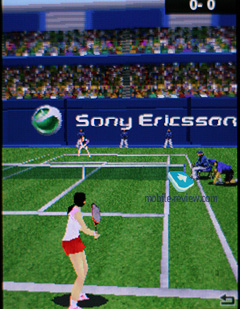
There are two applications found in the C905: AccuWeather, CamPlus, PhotoMate, SlideShow Wall and World Clock 3D.

As far as multimedia feats are concerned, the C905 is a standard A200 fare - read more about it here.
Apart from the player, the C905 also packs in FM-radio.
Video call – since the C905 doesn't pack in a forward-facing video camera for video-conferencing, it allows you to utilize the main camera module for these purposes or set any video clip as the background during a video call
Back to the table of contents>>>
Capuchin Project
The C905 is Sony Ericsson's first phone to support JP-8.4 - a new Java platform that ships with all the benefits of previous editions and adds support for Capuchin project on top of that. Effectively, it's an attempt to break away from the restraints of A200 platform, since you can go only this far with Java applications, especially when it comes to graphics. So, the solution Sony Ericsson have come up with is quite elegant - they have enabled developers to throw flash clips into their Java apps, which is a very strong move that can potentially become a good alternative to smartphone functionality, provided that it'll spread beyond this particular phone. The question remains, however, whether Nokia will go on and implement Capuchin project into their handsets. In my opinion, the answer couldn't be more clear-cut - no, otherwise they'd create a threat to their ever-growing sales of S60-based solutions. It seems that at the end of the day Sony Ericsson will be the only phone maker utilizing this technology, as it's quite unlikely that Samsung will want to take part in it.
So far we have managed to dig out only four applications showcasing what project Capuchin can do. One of them is the all-time classics - Hello World prompt; the two other ones feature an animated clock (that won't start up on the C905, however) and task list. And the last, but not the least, boasts a flash-based interface for the pedometer application. It's not much, by any stretch of imagination, but this platform has got some potential and will allow for a wealth of capable and well-designed applications down the road. It's quite another matter though that Sony Ericsson's programmers will be the ones in charge of it, but seeing how feeble their efforts have been on this field (with phone themes in particular - the flash framework is still pretty weak; and there is not a slew of themes out there either) there is no reason to be overly optimistic about the future of Capuchin-based software. At the same time, third-party developers won't have nearly enough motivation to write these Java apps exclusively for Sony Ericsson branded phones or tweak already existing ones with some flash-based adornments.
We'll see how it will work out for Sony Ericsson very soon - so far, this technology appears to be quite promising, but they'll need to back it up with some real solutions too.
Back to the table of contents>>>
Impressions
Even though the C905 comes equipped with only one loudspeaker, it's pretty loud and won't let you miss a call in pretty much any environment. However, considering the phone size, you'd expect it to rock somewhat louder; unfortunately, it's not the case here. As far as reception quality goes, the Sony Ericsson C905 was an okay performer without any significant letdowns or strengths. The vibro alert is a bit above average strength-wise - you'll feel it even though clothes, make no mistake about that.
Now we get to the Sony Ericsson C905 main problem. Sony Ericsson has recommended the price of 550 Euro, which is exactly the price bracket where the Samsung INNOV8 resides in. Needless to say it tears the C905 apart on almost every single front and, more importantly, it has been on sale for almost a month now. Being an S60 smartphone with 16 Gb of storage onboard (we will see a pared-down 8 Gb edition down the road too, although it'll be almost 100 Euro cheaper), support for memory cards, 3.5 mm audio jack, huge display, rock solid build, comparable battery time and a DSP, it's a clear winner if it's price/quality ratio that matters to you most. Techi, who have always been one of the key audiences for Sony Ericsson and C905-esque solutions, will sway more towards the Samsung INNOV8 as well. The most adequate price for the C905 would be 400-450 Euro or so, but at this point all it can count on are very marginal sales, especially given the feedback from its potential distributors.
Furthermore, Sony Ericsson already have got C905-esque solutions in their portfolio, like the G705 that comes armed with exactly the same feature pack, bar the megapixel count. It's definitely worth a glance or two, and its price tag isn't all that wallet-bashing at just 350 Euro.
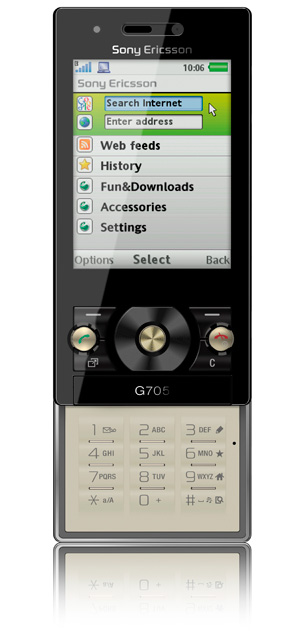
We would really like to see the imaging-savvy flagship pack in if not all, then most of state-of-the-art features. Unfortunately it's not the case with the Sony Ericsson C905 - while they could have made up for the lack of functions by setting a more adequate price tag, it seems it's not the way Sony Ericsson prefer to do business these days.
Related links:
Back to the table of contents>>>
Eldar Murtazin (eldar@mobile-review.com)
Translated by Oleg Kononosov (oleg.kononosov@mobile-review.com)
Published — 20 October 2008
Have something to add?! Write us... eldar@mobile-review.com
|
News:
[ 31-07 16:21 ]Sir Jony Ive: Apple Isn't In It For The Money
[ 31-07 13:34 ]Video: Nokia Designer Interviews
[ 31-07 13:10 ]RIM To Layoff 3,000 More Employees
[ 30-07 20:59 ]Video: iPhone 5 Housing Shown Off
[ 30-07 19:12 ]Android Fortunes Decline In U.S.
[ 25-07 16:18 ]Why Apple Is Suing Samsung?
[ 25-07 15:53 ]A Few Choice Quotes About Apple ... By Samsung
[ 23-07 20:25 ]Russian iOS Hacker Calls It A Day
[ 23-07 17:40 ]Video: It's Still Not Out, But Galaxy Note 10.1 Gets An Ad
[ 19-07 19:10 ]Another Loss For Nokia: $1 Billion Down In Q2
[ 19-07 17:22 ]British Judge Orders Apple To Run Ads Saying Samsung Did Not Copy Them
[ 19-07 16:57 ]iPhone 5 To Feature Nano-SIM Cards
[ 18-07 14:20 ]What The iPad Could Have Looked Like ...
[ 18-07 13:25 ]App Store Hack Is Still Going Strong Despite Apple's Best Efforts
[ 13-07 12:34 ]Infographic: The (Hypothetical) Sale Of RIM
[ 13-07 11:10 ]Video: iPhone Hacker Makes In-App Purchases Free
[ 12-07 19:50 ]iPhone 5 Images Leak Again
[ 12-07 17:51 ]Android Takes 50%+ Of U.S. And Europe
[ 11-07 16:02 ]Apple Involved In 60% Of Patent Suits
[ 11-07 13:14 ]Video: Kindle Fire Gets A Jelly Bean
Subscribe
|
